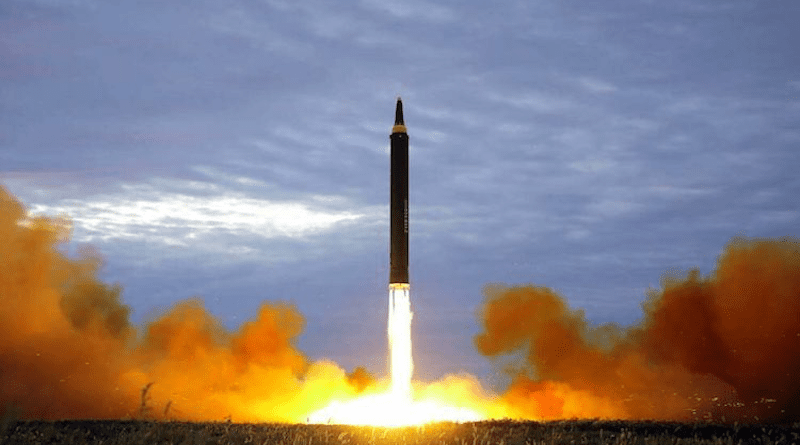Time To Worry About Nuclear Expansion In North Korea – Analysis
North Korea has been busy developing a multitude of weapons systems, and miniaturizing them, the result of which is a shift in the country’s strategic and tactical outlook.
The unveiling of miniaturized nuclear warheads by Supreme Leader Kim Jong Un is a significant step for Pyongyang’s efforts to enhance its capabilities. A few weeks ago, the country launched two cruise missiles from a submarine for the first time, illustrating that it possesses increasingly diverse missile systems that could survive any attempts at “decapitation” or “preemption.”
In addition, comments made by North Korean authorities about Russia are important, so a look at what is happening now and where things are going is important. When the supreme leader’s sister, Kim Yo Jong, North Korea’s chief strategic commentator, talks about the nation’s nuclear weapons being fired westward rather than over the Pacific, that is a change in strategy that resonates beyond mere rhetoric.
Her comments come at a time when her country is trying to establish closer ties with Russia, given that Pyongyang and Moscow continue to be isolated by the West. North Korea has repeatedly supported Moscow’s position since the Russian invasion of Ukraine last year.
In a particularly serious development, North Korea unveiled its new, smaller nuclear warheads and vowed to produce more weapons-grade nuclear material with which to expand its arsenal.
The supreme leader visited the nation’s Nuclear Weapons Institute and inspected the new tactical nuclear weapons and the technology for mounting warheads on ballistic missiles, as well as nuclear counterattack plans. He ordered the production of weapons-grade materials to boost the country’s nuclear arsenal “exponentially.”
All this may indicate North Korea has made progress in miniaturizing powerful warheads that are small enough to mount on intercontinental ballistic missiles capable of striking the US or other targets.
North Korea also reported that Kim was briefed on an information technology-based, integrated nuclear weapon-management system called “Haekbangashoe,” which translates as “nuclear trigger.” Its accuracy, reliability and security “were verified during the simulation of a nuclear counterattack exercises.”
All this information may be at least partly true, and it is therefore best to err on the side of caution when considering it. Pushing back against North Korea when its relationship with Russia is so close could be difficult, which might help to explain Pyongyang’s recent stance and actions toward the US, South Korea and Japan.
Weapons scientists note North Korea has completed the development of missile-delivery systems that can be used, for example, from a submarine, a lake, a train, and a number of other locations. Combined with its showing off of miniaturized nuclear weapons, this means Pyongyang could begin to produce dozens of warheads based on eight delivery systems. This is a major step forward and makes the country a bigger and more dangerous threat.
North Korea is now likely to carry out a seventh nuclear test. The previous six, between 2006 and 2017, were preceded by an escalating series of missile tests. Experts who anticipate another imminent test say it would probably involve the new, smaller warheads, designed to fit on cruise missiles so that they can target South Korea, Japan and other countries around the Pacific theater.
The growing power of Kim Yo Jong was evident in the appearance of her niece at a previous missile launch. Her statements about nuclear responses have referenced Japan, and Tokyo pointed out that the North Korean military already launched a ballistic missile that flew over Japan in October last year, and test-fired an intercontinental ballistic missile that landed in an exclusive Japanese economic zone a month later, prompting emergency warning systems to activate and order residents to take cover.
Kim Yo Jong was specific in her warning: “The Pacific does not belong to the United States or Japan.”
Regarding Pyongyang’s relations with Moscow, rhetoric from Kim Yo Jong about fighting in the trenches alongside Russian troops and threats to the Ukrainian government are signals that North Korea’s strategic scope is expanding. She is looking to use Russia as a springboard to Europe, and her rhetoric about sending hundreds of thousands of North Koreans there has resonated within the information sphere, a phenomenon that needs to be shut down.
North Korea’s ability to send its citizens to other parts of the world to work in difficult situations is nothing new; it has been happening in Africa for years, from laborers to doctors. So when Kim Yo Jong talks about North Korean “brigades,” she is making reference to the use of these physicians and other workers in distant places.
She is an increasingly prominent presence in nuclear weapons rhetoric and the decision-making process about their use. North Korea’s nuclear capability is growing rapidly and the ruling dynasty is currently in a solid international position, given the chaos raging in other geopolitical theaters around the world. A nuclear test is just the cherry on the cake for the country’s authorities.

